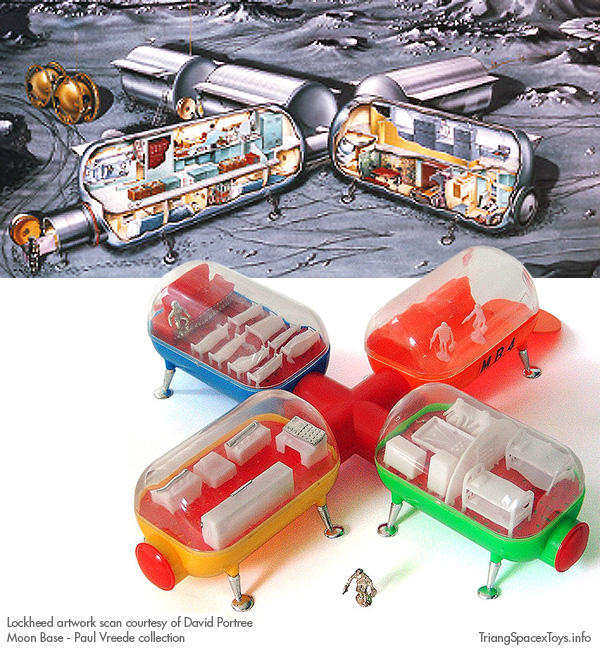
The precise origin of the Spacex Moon Base was first found by Mark McClellan, in a booklet produced for the Science Service in Washington DC. Called Man in Space, it was first published in 1967 by Doubleday in the US and Odhams in the UK. I own a second edition from 1969, which must have been revised (1) because it includes photos of the first Moon landing, replacing earlier content. The identification of the moon base has also disappeared!
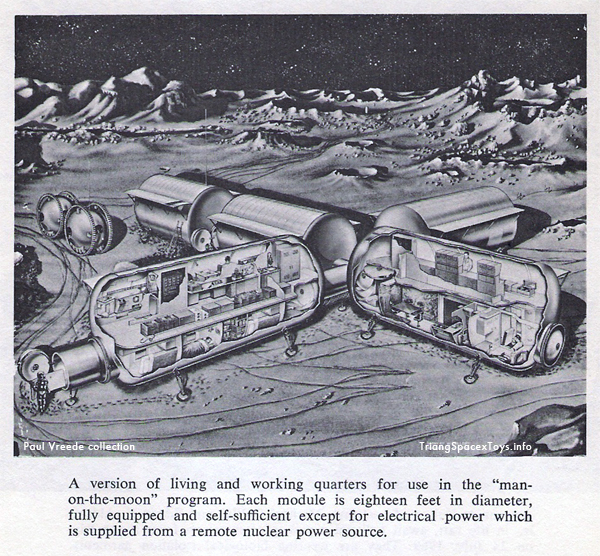
The Lockheed base pictured in Man in Space, 1969 edition (above) and 1967 caption (below)

The artists at Century 21 must have seen the Lockheed concept art a few years earlier, because it was included in an article by Bill "Roger" Dunn appearing in issue #41, published 30 October 1965 (Bill Dunn was a press attaché at the US Embassy, which is how he will have obtained the Lockheed images). It is most likely that this is also how the designers of the Spacex blister cards got the image, which they used on the card back instead of a photograph of the toy itself. I imagine this is because at that time the toy moon base was still in development.
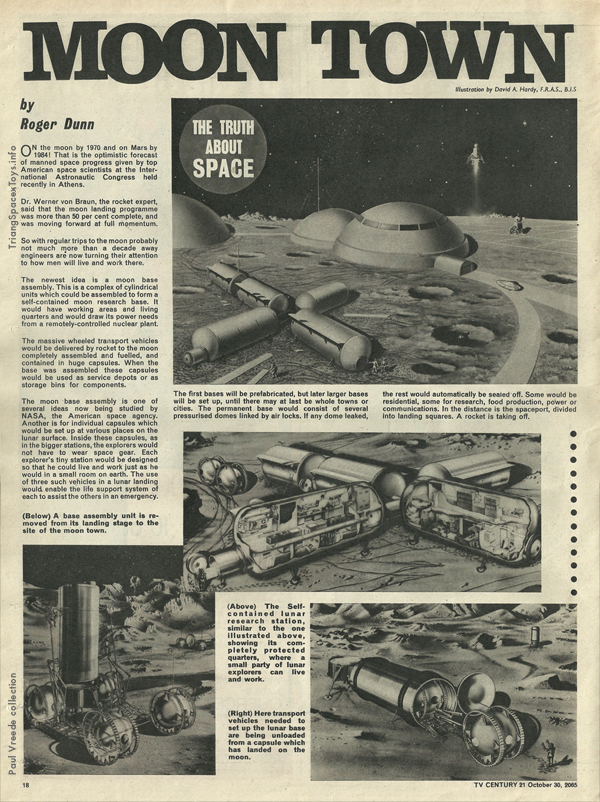
Moon Town article from TV21 #41 (2), click for readable version in new window.
As to the real moon base concept, this was developed by Lockheed on their own initiative, hoping to get involved in this type of project after President Kennedy boldly promised a Moon landing "before this decade is out." Space historian David Portree has been lucky in having had access to the apparently sole surviving copy of the report about this project (including the only pictures in colour), and has written a comprehensive blog post about it. Although his Altair IV blog has sadly disappeared, he has most kindly given me permission to include his post here.
Lockheed moon base (1962-1963)
by David S F Portree, originally published on his Altair IV blog
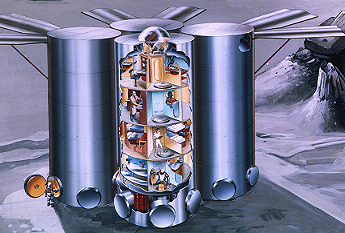
Aerospace companies in the U.S. naturally saw President John F. Kennedy's May 1961 call for a man on the moon as a profit-making opportunity, and quickly moved to position themselves to take advantage of NASA lunar contracts. Lockheed Missiles and Space Company, for example, believed that Kennedy's call might lead to a permanent U.S. presence among the moon's jagged mountains, dust seas, and rugged craters, so it launched an in-house lunar base study called Extended Lunar Operations (ELO).
Lockheed briefed its study results to NASA officials. The company hoped that, in the short term, ELO would prepare it to conduct NASA-funded lunar base studies should the space agency decide to contract for them, and, in the long term, would improve its chances of receiving lucrative NASA contracts to build lunar base hardware. Lockheed tapped as its ELO launch vehicle the three-stage Apollo Saturn C-5 rocket, possibly with high-energy chemical propellants or a nuclear third stage. The Saturn C-5 third stage would place on course for the moon two 18-foot-diameter rocket stages and an attached ELO payload. A 10.8-foot-long braking stage would ignite during approach to the moon to place a 12.5-foot-long landing stage and attached ELO payload into lunar orbit. The spent braking stage would then separate, and the landing stage would lower the payload to the lunar surface. ELO stages, modules, and other hardware would be based to the extent possible on technology developed for Apollo.
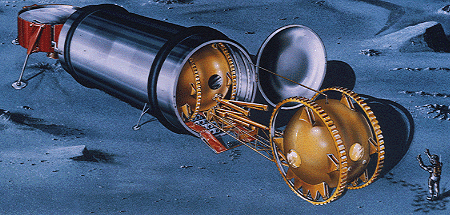
The first ELO landings in 1969 would deliver two cylindrical cargo modules, each containing one Lunar Traverse Vehicle (LTV) rover. Astronauts would then land nearby in one or more Apollo Lunar Excursion Modules. They would inflate toroidal "bumpers" girdling the top and bottom of each cargo module and tip it onto its side, then would uncap the modules and drive the LTVs out onto the moon.
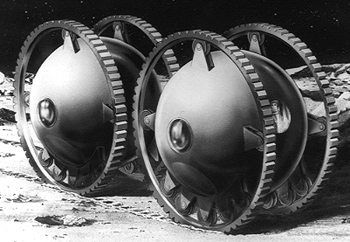
Lockheed called the LTV a "mobile station" for lunar exploration, but it would really constitute the ELO program's prime mover, since it would serve also to transport base modules and equipment. The LTV could cover 1000 miles in two weeks at five miles per hour. It would weigh 1700 pounds on the moon, where gravity pulls with one-sixth the force it does on Earth. Two 12-foot-diameter spherical compartments would provide living and working space for four men. Each compartment would include a 768-pound cylindrical airlock that would double as a solar flare shelter. The LTV's four 16-foot-diameter solid metal wheels - less likely than pneumatic tires to suffer damage from sharp lunar rocks, the company explains - would provide adequate traction in lunar gravity and enable the LTV to bridge crevasses up to eight feet wide. Eight bogeys would link each wheel to its sphere. Seven would be passive rollers, while the eighth would include gear teeth for transmitting power to the wheel from an electric motor inside the sphere. Steering would be through differential power application - that is, when less torque was applied to the wheels on the left side, the LTV would make a left turn.
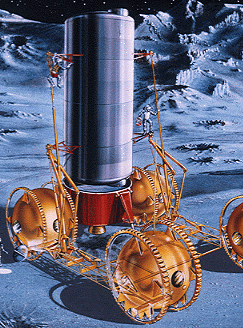
The astronauts would link the first two LTVs together using module-handling equipment, an assemblage of cranes and cradles that would enable them to unload an 18-foot-diameter, 42-foot-long, 28,000-pound lunar base module from its landing stage, transport it to the base location, and position it on the surface.
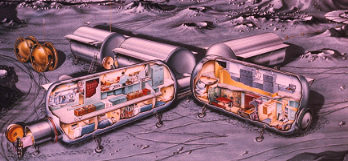
Base modules would arrive on the moon fully outfitted with internal equipment. The permanent ELO base configuration, in place in 1975, would include five cylindrical horizontal modules on adjustable legs. Wing-like thermal radiators with removable panels for easy meteor damage repair would ensure that the air temperature inside the modules remained near 80 degrees Fahrenheit. Replaceable meteor shrouds would shield tubular crawlways linking the modules.
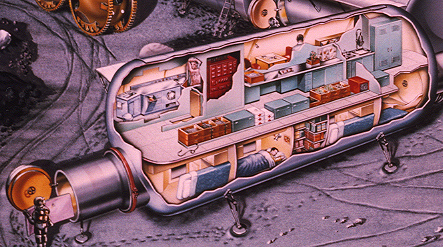
In a typical module, the main airlock would open onto a straight passage running the length of the lower deck. Hatches in the passageway floor would lead down into a cramped "solar flare protection cell" lined with water tanks. The lower deck would include sleep compartments for six astronauts, a galley, and environmental control systems, while the upper deck would contain a laundry, showers, a toilet, the central electrical control room, and laboratory/workshop space. Lockheed reckons that, in the moon's low gravity, the astronauts could move between the two decks without a ladder or stairs. The company also briefly considered a vertical base module configuration (see top image).
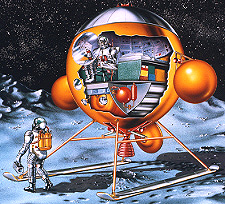
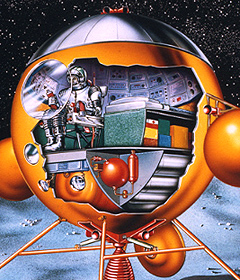
Lockheed's two-man Lunar Surface Ballistic Vehicle (LSBV) would "hop" over the lunar landscape using a nitrogen tetroxide/hydrazine rocket motor. The motor would fire briefly to lob the LSBV onto a suborbital path, then again to slow it to a gentle touchdown at a remote exploration site. Twin landing skids would cant out of way of the rocket blast in flight. The crew would ride inside a 12-foot-diameter spherical cabin topped by a silver thermal insulation "beanie cap" that would ward off heat from its pitch/roll thrusters and from harsh lunar sunlight. The LSBV, which would weigh 775 pounds on the moon, would need to carry 1250 pounds of propellants in its twin spherical side-mounted tanks to make a 200-mile round trip flight. Short trip time would be the LSBV's chief advantage over the LTV; a 200-mile LSBV flight would last 15 minutes, while a 200-mile LTV traverse would need 40 hours.
ELO base development would begin in 1962 with the start of the ELO study and automated Ranger hard-lander missions. The Rangers would gather data on lunar conditions for moon base hardware designers. Design of preliminary ELO hardware based on Apollo systems would begin as early as 1963 and last until to 1970. Meanwhile, increasingly ambitous lunar exploration missions would occur. Automated Surveyor A landers would fly from 1964 to early 1976 to gather more surface data, and Surveyor B orbiters would map the moon from mid-1965 to mid-1976. The first manned lunar missions, circumlunar and lunar-orbital Apollo B flights, would commence in late 1966. These would pave the way for Apollo C manned landings in 1968 and 1969. Apollo C missions, which would scout lunar base sites, would remain on the moon for no more than two Earth days.
The first ELO base hardware would reach the moon in 1969, and "Extended" Apollo missions with surface stays of up to two weeks would occur in 1970. In mid-1971, NASA would establish an "interim lunar exploratory base" for three-month lunar stays. This would expand in 1974 into a "semi-permanent" ELO base permitting six-month stays. The 1975-1980 period would see a permanent ELO base enabling "unlimited operations" on the moon.
Though Lockheed offered an optimistic lunar base schedule, it acknowledged that NASA's moon program was likely to evolve through a series of key decision points, any one of which could mean the end of U.S. lunar exploration. The Ranger and Surveyor probes would produce the first decision point; their data might cause the U.S. to end all lunar exploration, continue with automated missions alone, or ("most optimistic from a manned lunar basing point of view") launch piloted Apollo circumlunar flights to take advantage of "Man's close up observation and judgment capabilities."
If piloted circumlunar reconnaissance revealed the moon to be "unsuitable for Man," then piloted exploration would likely cease before the first Apollo landing. Similarly, the discovery of "overwhelming obstacles" to lunar bases during Extended Apollo missions would likely terminate lunar exploration. Evolutionary decision points aside, NASA's lunar program might end at any time because of a "diversion of funding to other efforts," such as "interplanetary travel" or "prosecution of a war," or because of a "drastic change in politico-economic philosophy" in the United States.
Lockheed abandoned ELO in late 1963 as it became increasingly preoccupied with NASA-funded lunar studies, and nine years later, after six Apollo landings, the U.S. abandoned the moon. The ELO study produced a disorderly mass of documents, including an incomplete, unpublished final report (A Handbook for Lunar Basing) which survives today only because George Honzik, the Lockheed engineer who led the ELO study, kept the single copy he prepared.
Thirty years after the ELO study, during the Space Exploration Initiative (1989-1993), Honzik shared his documents with Lockheed staffers T. L. Stroup and R. D. Allen, who wrote an invaluable ELO overview ("Early Lunar Base Concepts: The Lockheed Experience, Part I," AAS 97-764; paper presented at the 43rd IAF Congress, August 28-September 5, 1992, Washington, D.C.). They also unearthed ELO information in the Lockheed technical library in Sunnyvale, California. In the mid-1990s, amid the turmoil of post-Cold War aerospace mergers and downsizing, the former Lockheed tech library discarded its ELO documents. Stroup subsequently made his ELO documents available to me for my erstwhile moon and Mars planning history website Romance to Reality.
© DAVID S. F. PORTREE
Read more from David at his fabulous Spaceflight History blog.
1: The Man in Space booklet also got a new cover - the 1967 edition has a white X-20 Dyna-Soar floating in space, while the 1969 edition has a LEM touching down on the Moon on the cover. back to text
2: The main illustration at the top of the Moon Town page in TV21 is by British artist David A. Hardy who is still alive. back to text